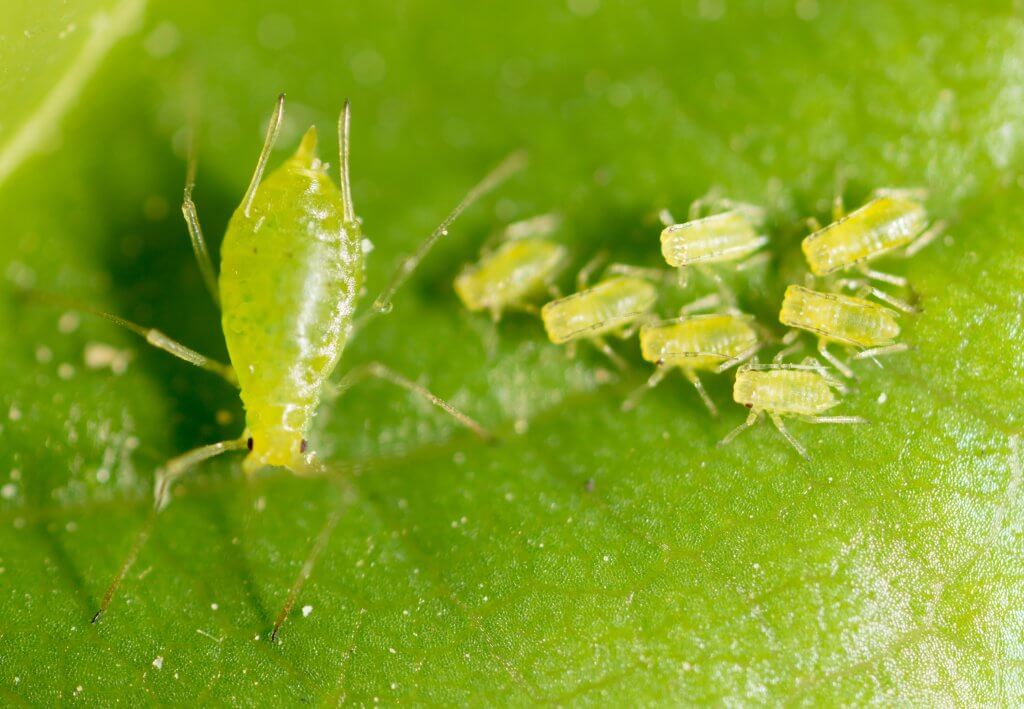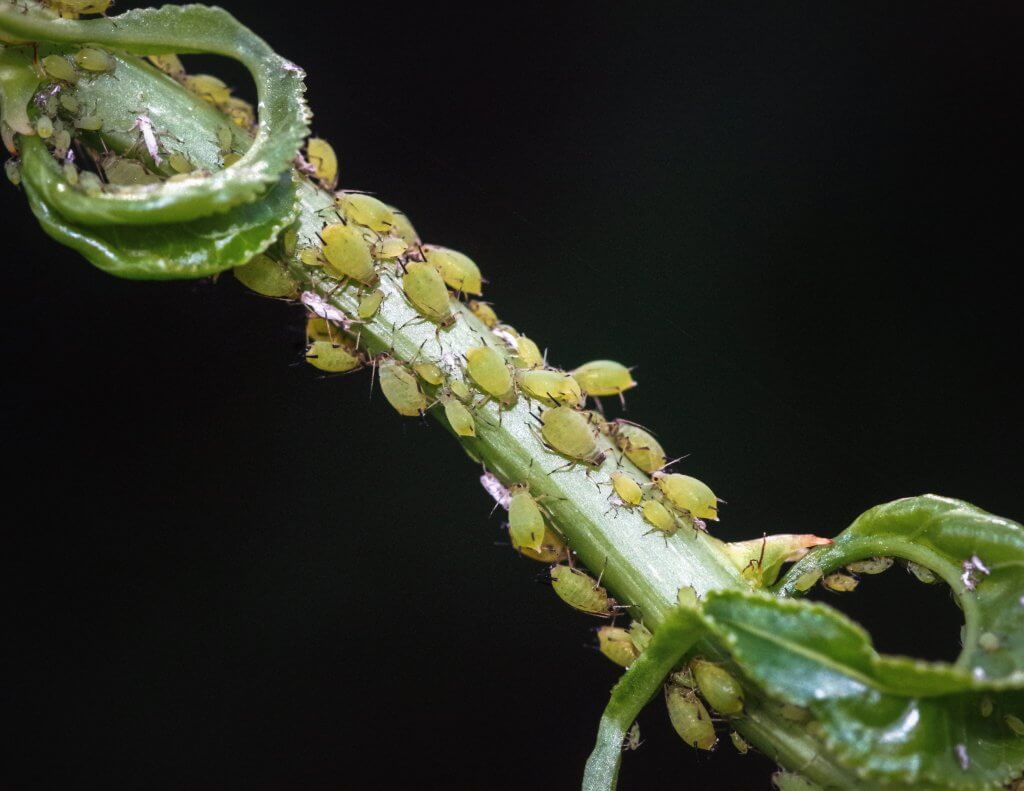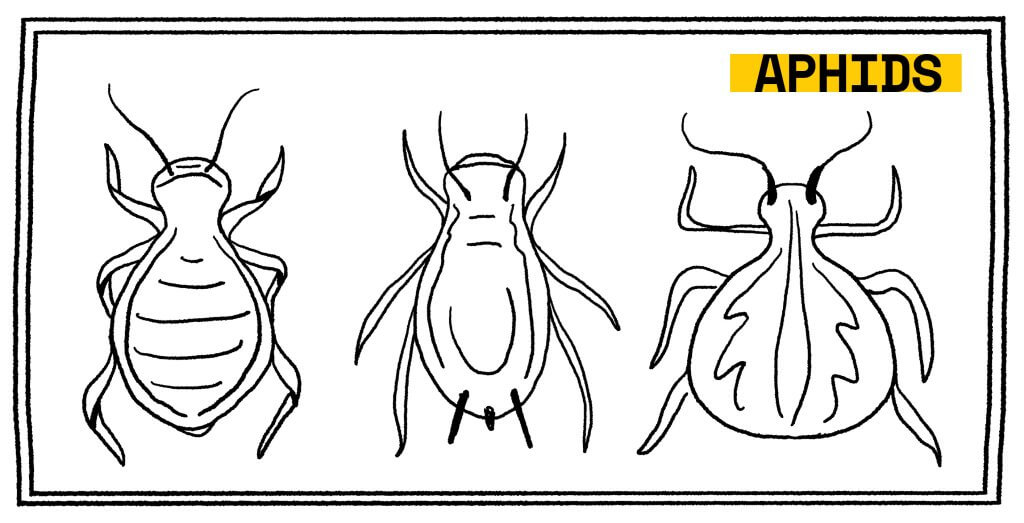Free Tropical Runtz seeds on orders over $150!
Aphids on cannabis can start out as a small problem but they can grow much worse if left unattended. Find out how to get rid of these troublesome insects below.
You may see aphids in many colors, depending on the stage of their life cycle and where you reside. Aphids on cannabis might be white, green, yellow, black, brown, or red. To be a cannabis pest in practically any part of the globe is possible since they are so prevalent. Watch out for the black-winged aphids, as they can be disastrous.

Common cannabis pests like aphids on cannabis are all too frequent. Adults are typically oval-shaped and have wings or antennae. Thin/long aphid nymphs are often whitish or light in color. Baby white aphids are so tiny that they seem like little white specks or eggs.
With their sucking mouthparts, cannabis aphids penetrate the leaves and feast on the liquids within. On the undersides of stems and leaves, they tend to form colonies. Infested cannabis plants might suffer from leaf damage and yellowing or wilting due to the stress and dehydration they are under.

Additionally, aphids on cannabis create vast quantities of “honeydew,” a delicious liquid waste that insects make. Sooty mold thrives in the honeydew droplets left behind by these aphids. Honeydew mold may develop on your plant’s leaves and branches, turning them black due to sooty mold accumulation. The tasty honeydew drips may also attract insects, like ants, which aggravates things.
When winged “colonizer” aphids arrive on your plant and deposit eggs this will infect your crops most likely. Even though aphids on cannabis plants with wings may not seem to be eating your cannabis, they are still a threat since they can produce eggs and start new colonies. Winged aphids are also called greenflies.
Outside, it’s tough to keep aphids away from your cannabis plants since it only takes a few flying aphids to get an infestation started. Your plant will become infested with a juvenile version of aphids that begin feeding on it.
Because of their rapid reproduction, a few winged aphid “colonizers” may produce hundreds or even thousands of aphids on pot plants within a few generations. A cannabis aphid infestation may go from bad to worse in just a few weeks!

Because of their voracious appetites, aphids on cannabis plants frequently keep reproducing on a plant until the plant becomes overstressed or overcrowded, resulting in the plant’s demise. Some are born with wings and fly out in search of a new plant victim to begin the process again. They start over with a new host.
Keep away from pesticides that affect the neurological system, such as malathion, Dursban, and Orthene (acephate). You should never apply these pesticides to cannabis. Generally speaking, if something isn’t suitable for edible plants, it’s also not safe for cannabis. If you want to get rid of bugs on cannabis plants, the following methods do the trick;
If you want to learn how to get rid of aphids on cannabis plants, you should know that you can avoid infestations of hemp aphids by catching them early. Inspect your plants regularly to ensure there are no “colonizer” aphids lurking in the grow room.

Look for clusters or colonies of tiny aphids on cannabis plant’s buds and on the undersides of the new leaves (or any other types of bugs on pot plants). The existence of these colonies indicates that the aphids have established themselves on the plants. The number of aphids will grow quickly numbers swiftly.
Reducing bugs on cannabis plants is never going to be easy. Depending on the severity of the infestation, one option is to relocate your plants outdoors and use a power sprayer to kill as many bugs as possible. It would help if you also discarded infected leaves and buds since they might spread the disease.
If you’re dealing with bugs and want to know how to get rid of aphids during flowering, fatty acid salts or insecticides might be helpful. They weaken aphids’ outer shells, but they’re safe for your plants to use and don’t leave much residue behind. It is crucial to coat your plant well with soap since it doesn’t last long, so you may need to reapply. Avoid getting any soap on your buds as this will affect the overall development.
When treating blossoming plants, avoid letting Neem Oil come in contact with your blooms since it will leave an unpleasant taste and odor behind. Use neem oil at your own risk, take precautions as it is potentially harmful to humans. The all-natural remedy known as neem oil, on the other hand, is very effective against a broad range of pests and mildew. A mister (also known as a “One-Hand Pressure Sprayer”) is necessary because neem oil and water may rapidly separate.
Spinosad Products (organic & safe) – Spinosad products are entirely safe for pets, children, and plants and are entirely organic. Spritzing Spinosad products liberally about your plants can help control aphid populations, mainly if you detect them behind the leaves. A milder pesticide than some more aggressive ones, it performs the job and is completely safe for use around plants, animals, and people.
Essentria IC3 Insecticide is a blend of organic and safe horticultural oils. However, it may be effective against the typical aphids pest in grow room when used correctly. Because it is only effective for around 8 hours on the plant, you will need to use it every day or combine it with other methods. To uniformly spray all the leaves, you’ll need a mister (sometimes known as a “One-Hand Pressure Sprayer”).
If you see aphids in late flower on your plants, the first thing you should do is cut off the contaminated portions and throw them away as soon as possible.
The plants will need to be hosed off with water or a water-vinegar solution to eliminate any leftover insects once you’ve trimmed them.
Many predatory insects naturally feed on aphids, including ladybugs, larvae of hoverflies, parasitic wasps, aphid midge larvae, and spider crabs (such as spider mites on cannabis and whiteflies). If you want to avoid an infestation, it’s better to introduce some of these insects to your garden in the spring and late summer. Insect predators aren’t effective against aphids that have previously been discovered on your plants.
Reintroducing predatory insects to your garden after an infestation has been eradicated can help keep your garden free of pests in the future. If you are more interested in killing aphids on cannabis, the above methods can work out.





Offers
This product is not for use by or sale to persons under the age of 18. This product should be used only as directed on the label. It should not be used if you are pregnant or nursing. Consult with a physician before use if you have a serious medical condition or use prescription medications. A doctor’s advice should be sought before using any hemp products. All trademarks and copyrights are property of their respective owners and not affiliated with nor do they endorse this product. These statements have not been evaluated by the FDA. This product is not intended to diagnose, treat, cure or prevent any disease. By using this site you agree to follow the Privacy Policy and all Terms & Conditions printed on this site. All products contain less than 0.3% Cannabinoid-compliant with applicable Federal Laws. Please make yourself aware of any and all applicable laws regarding hemp in your jurisdiction. Premium Cultivars accepts no liability or responsibility regarding germination laws in any specific locale state or national jurisdictions.THCA products are not available for shipment to the following states: Hawaii, Idaho, Minnesota, Oregon, Rhode Island, Utah, Vermont *Note: Products with Total THC content above 0.3% must not be shipped to these states.
We want to help you get your hands on the seeds you want, take 20% off your next purchase when you enter your email below!
We want to help you get your hands on the seeds you want, take 20% off your next purchase when you enter your email below!